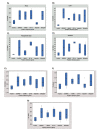Evaluating and Validating Sunflower Reference Genes for Q-PCR Studies Under High Temperature Condition
- PMID: 37228632
- PMCID: PMC10203189
- DOI: 10.30498/ijb.2023.338375.3357
Evaluating and Validating Sunflower Reference Genes for Q-PCR Studies Under High Temperature Condition
Abstract
Background: Q-PCR is the method of choice for PCR- based transcriptomics and validating microarray-based and RNA-seq results. Proper application of this technology requires proper normalization to correct as much as possible errors propagating during RNA extraction and cDNA synthesis.
Objectives: The investigation was performed to find stable reference genes in sunflower under shifting in ambient temperature.
Materials and methods: Sequences of five well-known reference genes of Arabidopsis (Actin, Ubiquitin, Elongation factor-1, GAPDH, and SAND) and one well-known reference gene inhuman, Importin, were subjected to BLASTX against sunflower databases and the relevant genes were subjected to primer designing for q-PCR. Two sunflower inbred lines were cultivated at two dates so that anthesis occurred at nearly 30 °C and 40 °C (heat stress). The experiment was repeated for two years. Q-PCR was run on samples taken for two planting date separately at the beginning of anthesis for each genotype from leaf, taproots, receptacle base, immature and mature disc flowers and on pooled samples comprising of the tissues for each genotype, planting dates and also all tissues for both genotypes and both planting dates. Basic statistical properties of each candidate gene across all the samples were calculated. Furthermore, gene expression stability analysis was done for six candidate reference genes on Cq mean of two years using three independent algorithms, geNorm, Bestkeeper, and Refinder.
Results: Designed primers for Actin2, SAND, GAPDH, Ubiquitin, EF-1a, and Importin yielded a single peak in melting curve analysis indicating specificity of the PCR reaction. Basic statistical analysis showed that Actin2 and EF-1a had the highest and lowest expression levels across all the samples, respectively. Actin2 appeared to be the most stable reference gene across all the samples based on the three used algorithms. Pairwise variation analysis revealed that for samples taken under ambient temperature of 30 °C, Actin2, EF-1a, SAND and for those taken under ambient temperature of 40 °C, Actin2, EF-1a, Importin and SAND have to be used for normalization in q-PCR studies. Moreover, it is suggested that normalization to be based on Actin2, SAND and EF-1a for vegetative tissues and Actin2, EF-1a, SAND and Importin for reproductive tissues.
Conclusions: In the present research, proper reference genes for normalization of gene expression studies under heat stress conditions were introduced. Moreover, the presence of genotype-by- planting date interaction effects and tissue specific gene expression pattern on the behavior of the most three stable reference genes was indicated.
Keywords: Heat stress; Reference genes; Sunflower.
Copyright: © 2021 The Author(s); Published by Iranian Journal of Biotechnology.
Figures





Similar articles
-
Identification and validation of quantitative real-time reverse transcription PCR reference genes for gene expression analysis in teak (Tectona grandis L.f.).BMC Res Notes. 2014 Jul 22;7:464. doi: 10.1186/1756-0500-7-464. BMC Res Notes. 2014. PMID: 25048176 Free PMC article.
-
A critique of widely used normalization software tools and an alternative method to identify reliable reference genes in red clover (Trifolium pratense L.).Planta. 2012 Nov;236(5):1381-93. doi: 10.1007/s00425-012-1682-2. Epub 2012 Jun 21. Planta. 2012. PMID: 22718310
-
Evaluation of suitable reference genes for qRT-PCR normalization in strawberry (Fragaria × ananassa) under different experimental conditions.BMC Mol Biol. 2018 Jun 22;19(1):8. doi: 10.1186/s12867-018-0109-4. BMC Mol Biol. 2018. PMID: 29933763 Free PMC article.
-
Influence of heat stress on reference genes stability in heart and liver of two chickens genotypes.PLoS One. 2020 Feb 6;15(2):e0228314. doi: 10.1371/journal.pone.0228314. eCollection 2020. PLoS One. 2020. PMID: 32027666 Free PMC article.
-
Selection of reference genes for quantitative real-time PCR expression studies of microdissected reproductive tissues in apomictic and sexual Boechera.BMC Res Notes. 2011 Aug 19;4:303. doi: 10.1186/1756-0500-4-303. BMC Res Notes. 2011. PMID: 21851639 Free PMC article.
Cited by
-
HaMADS3, HaMADS7, and HaMADS8 are involved in petal prolongation and floret symmetry establishment in sunflower (Helianthus annuus L.).PeerJ. 2024 Jul 2;12:e17586. doi: 10.7717/peerj.17586. eCollection 2024. PeerJ. 2024. PMID: 38974413 Free PMC article.
-
Selection of Suitable Reference Genes for RT-qPCR Gene Expression Analysis in Centipedegrass under Different Abiotic Stress.Genes (Basel). 2023 Sep 26;14(10):1874. doi: 10.3390/genes14101874. Genes (Basel). 2023. PMID: 37895223 Free PMC article.
References
-
- Martins MQ, Fortunato AS, Rodrigues WP, Partelli FL, Campostrini E, Lidon FC, et al. Selection and validation of reference genes for accurate RT-qPCR data normalization in Coffea spp. under a climate changes context of interacting elevated (CO2) and temperature. Front Plant Sci. 2017;8:307. doi: 10.3389/fpls.2017.00307. - DOI - PMC - PubMed
LinkOut - more resources
Full Text Sources
Research Materials
